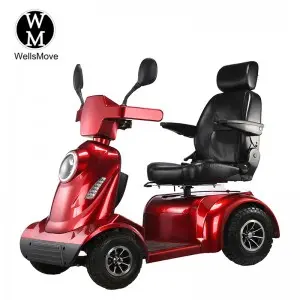A comprehensive guide to precautions for elderly people with limited mobility when using mobility scooters
Introduction
With the intensification of the global aging trend, mobility scooters have become an important tool for many elderly people with limited mobility to travel. For international wholesale buyers, understanding the precautions for elderly people using mobility scooters will not only help provide customers with better products and services, but also enhance their own competitiveness in the market. This article will elaborate on the key matters that elderly people with limited mobility need to pay attention to when using mobility scooters from multiple aspects.
1. Preparation before use
Vehicle inspection: Before each use, the elderly should carefully check the various parts of the mobility scooter. For example, check whether the tire pressure is sufficient, whether the tire has wear, cracks or bulges; check whether the brake system is sensitive and effective, and whether the brake pads need to be replaced; ensure that the steering wheel turns flexibly without stagnation or looseness; check whether the seat, armrests and pedals are firm and reliable; for electric mobility scooters, it is also necessary to pay attention to whether the power is sufficient and whether the battery has leakage or expansion.
Personal protection: The elderly should take appropriate personal protection measures according to the type of mobility scooter and the use environment. When using a non-enclosed tricycle, it is recommended to wear a safety helmet that meets the 3C certification standards to prevent accidental impact on the head. For fully enclosed electric tricycles, etc., you must correctly fasten your seat belt after getting on the vehicle to ensure that your body is effectively fixed and protected during driving.
Familiar with the operation: If the elderly are using a mobility scooter for the first time, they must first conduct operation training in a safe and open area to familiarize themselves with the vehicle’s starting, acceleration, steering, braking and other operating methods, and then drive on the road after mastering them. At the same time, you must understand the performance and characteristics of the vehicle, such as the maximum speed, cruising range, load limit, etc., so as to use and maintain it reasonably.
2. Safety precautions during driving
Comply with traffic rules: When the elderly use mobility scooters to travel, they must strictly abide by local traffic rules. When driving on the road, you must take the motor vehicle lane or non-motor vehicle lane, depending on the type of mobility scooter and local traffic regulations. Drive according to the instructions of traffic lights and traffic signs, do not run red lights, do not go against the flow, do not change lanes or turn around at will, and ensure the traffic safety of yourself and others.
Control the speed: Considering that the elderly have a relatively slow reaction speed, you should keep a low speed when driving a mobility scooter and avoid high speed. When turning, going up and downhill, and passing through complex sections such as crosswalks or intersections, you should slow down in advance to ensure safe passage. It is generally recommended to control the speed at around 5-10 kilometers per hour, which can be adjusted appropriately according to the actual situation and personal driving ability.
Pay attention to the road conditions: The elderly should always be vigilant and closely observe the surrounding road conditions and traffic conditions. During driving, pay attention to avoid pedestrians, vehicles and other obstacles, especially in places with large traffic, narrow roads or poor visibility, and drive more carefully. In case of emergencies, stay calm and take correct avoidance measures to avoid accidents.
Avoid dangerous behaviors: It is strictly forbidden to drive on the fast lane to avoid traffic congestion or being rear-ended by the following vehicle. Do not drive a mobility scooter after drinking. Alcohol will affect the judgment and reaction ability of the elderly and increase the risk of accidents. At the same time, avoid using the mobility scooter in bad weather conditions, such as heavy rain, strong wind, heavy fog, etc. If you really need to travel, you should choose other safer modes of transportation.
3. Vehicle maintenance and care
Regular cleaning: Clean the mobility scooter regularly, including wiping the body, cleaning the seats, cleaning the tire gaps, etc. This not only keeps the appearance of the vehicle clean and tidy, but also promptly detects potential problems on the surface of the vehicle, such as rust, scratches, etc. During the cleaning process, be careful to avoid water entering the charging socket and electronic components of the vehicle body to prevent short circuits or damage.
Battery maintenance: The battery is one of the core components of the electric mobility scooter. The correct battery maintenance method can extend the battery life. Overcharging and over-discharging should be avoided. The general charging time is controlled at about 6-8 hours. For specific recommendations, please refer to the vehicle manual. When charging, it is best to use the original charger and place the vehicle in a well-ventilated place. For mobility scooters that are not used for a long time, the battery should be charged once every month or so to maintain the battery activity.
Parts inspection and replacement: Regularly check the various parts of the scooter, such as screws, nuts, bearings, chains, etc., and tighten or replace loose or damaged parts in time. At the same time, pay attention to check the lubrication of the vehicle and regularly add lubricating oil to the parts that need lubrication to reduce friction and wear and ensure the normal operation of the vehicle.
Professional maintenance: It is recommended to send the scooter to a professional maintenance agency for comprehensive inspection and maintenance every year. Professional technicians will test and debug the key components of the vehicle such as the motor, controller, and electrical system to promptly discover and solve potential problems and ensure the safety and reliability of the vehicle.
4. Choose a suitable scooter for the elderly
Consider the user’s physical condition: Choose a scooter suitable for the elderly based on factors such as the degree of mobility inconvenience, physical fitness, height and weight. For example, for the elderly with weak lower limb strength, a three-wheeled or four-wheeled scooter with pedals and seats can be selected; for the elderly who are weaker and need more support, a high-back seat scooter with a backrest and armrests can be considered.
Pay attention to the safety performance of the vehicle: give priority to scooters equipped with electromagnetic brake systems, stability control systems, airbags and other safety devices. These safety configurations can provide better protection for the elderly in emergency situations and reduce the risk of accidents and the degree of injury. At the same time, check whether the braking distance of the vehicle meets the safety standards. The more sensitive and reliable the brakes are, the safer it is to use.
Match the use environment: choose different types of scooters according to the daily use environment of the elderly, such as indoors, outdoors, community roads, parks, etc. If the elderly are mainly active indoors, you can choose a scooter that is small in size, easy to turn and control; if you often drive on outdoor roads, you should consider the vehicle’s stability, obstacle crossing ability, and whether it meets local road standards.
Pay attention to brand and quality: Choose a well-known and reputable brand scooter. These brands are usually more guaranteed in terms of product quality and after-sales service. At the same time, carefully check the vehicle’s production date, certificate of conformity, 3C certification and other information to ensure that you buy a qualified product that meets national safety standards.
5. Laws, regulations and compliance
Vehicle certification and qualifications: In many countries and regions, mobility scooters for the elderly need to obtain relevant certification and qualifications before they can be legally sold and used. For example, in China, regular mobility scooter manufacturers must be included in the “Catalogue of Road Motor Vehicle Manufacturers and Products” of the Ministry of Industry and Information Technology, and the vehicles must also have “three certificates” such as motor vehicle factory certificate, vehicle consistency certificate, and 3C certification. When purchasing, international wholesale buyers must ensure that the purchased mobility scooters meet the relevant certification and qualification requirements of the target market to avoid sales and use problems caused by non-compliance of vehicles.
Legality on the road: Understand and comply with local traffic regulations on the regulations on mobility scooters for the elderly on the road. In some places, mobility scooters for the elderly may need to be registered and hung with license plates, and drivers need to hold corresponding driver’s licenses to legally drive on the road. Buyers should clearly inform customers of these regulatory requirements and remind them to use mobility scooters legally to avoid penalties for illegal driving.
6. Precautions for special circumstances
Winter use: In the cold weather in winter, the performance of the battery will be affected to a certain extent, resulting in a shorter cruising range and longer charging time. Therefore, when the elderly use a mobility scooter in winter, they should plan their travel routes in advance and ensure that the battery is fully charged. At the same time, pay attention to keeping the battery warm and avoid parking and using the vehicle for a long time in a low temperature environment. In addition, when the road is icy or snowy, drive more carefully and try to avoid sudden braking and sharp turns. If necessary, install auxiliary devices such as anti-skid chains.
Night travel: If the elderly need to use a mobility scooter to travel at night, ensure that the vehicle’s lighting system works properly, including headlights, taillights, turn signals, etc., so that they can see the road clearly and be discovered by other vehicles and pedestrians. At the same time, it is recommended that the elderly wear reflective vests or paste reflective signs on the mobility scooter to improve the safety of night travel.
Accompany and assistance: For the elderly with poor physical condition, extremely weak mobility or limited cognitive ability, it is recommended that family members or caregivers accompany them when using the mobility scooter so as to provide help and assistance when needed. Accompanying personnel can help the elderly get on and off the vehicle, operate the mobility scooter, deal with emergencies, etc., to ensure the safety of the elderly’s travel.
7. Summary
When elderly people with limited mobility use mobility scooters, they need to pay attention to the following matters, including preparation before use, safety during driving, vehicle maintenance, selection of suitable models, compliance with laws and regulations, and response to special circumstances. When promoting and selling mobility scooters, international wholesale buyers should fully understand and communicate these matters, which will not only help improve the safety and reliability of the products, enhance user satisfaction and loyalty, but also establish a good corporate image and expand market share.
Post time: Jun-16-2025



